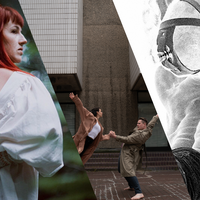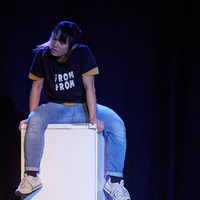Thu 18 Jan: Jack Trotter, Jorden Brooks and Vanessa Tang

News Story
Jack Trotter Several desperate attempts
Jorden BrooksStep Jockey
Vanessa tang(Un)do
Co-directed by Vanessa Tang and Natalie Pirarak, choreographed by Congfang Xiao (Spring) and performed by Sandy Hoi Shan Yip, Un(do) feels exactly like desperately trying to fall asleep at the end of a hectic day, when your mind refuses to shut itself down. Using guided breathing techniques and ASMR sounds, their transdisciplinary performance aims to present healing as aligning the physical, emotional and mental bodies through dance. Yip’s fluid movements recall that of a modern Atlas and are echoed through water cymatics, mirroring imaginary dives into her inner abyss. The performer, having mentally sunk to the bottom of the ocean, watches her distorted reflection in the ripples spread across the water and collapses into the fetal position. (Un)do becomes a compelling visual embodiment of what healing can look like, setting the perfect ground for its future development into a more robust piece.
Pulling an all-nighter at the club has never felt quite like the exhilarating techno trance in Step Jockey. Choreographed with incredible preciseness by Jorden Brooks, Allegra Vistalli and Euan Stephen’s repetitive but perfectly synchronized build-up of moves brings the dancefloor to life, accompanied by DJ Balbo’s live mixing of electronic dance music. Watching their show, you can clearly notice a special creative bond between the performers and the DJ. Their minimalistic yet charming approach to the cyclical nature of clubbing definitely transcends the stage and sparks an infectious enthusiasm among spectators. There was even some loud cheering during the performance which goes to prove that Step Jockey’s rendition of four-on-the-floor is truly a skilful piece of work.
Several desperate attempts, choreographed by Jack Trotter and performed by seven dancers, excels at not taking itself too seriously when talking about the clout chasers of pop culture. Their dance-theatre performance opens up with a collective scream in the face of the absurdist battlefield that is stardom. From catwalk modeling to intrusive paparazzi and flashing lights, from camp to cancel culture, from loving the limelight to viscerally hating public attention – it is a validation-seeking world and we are all silent witnesses to its demise. Although it could certainly benefit from a clearer narrative structure, Several desperate attempts is a satirical rollercoaster ride through fame.
In Vanessa Tang and Natalie Pirarak’s (Un)do, dancer Sandy Hoi Shan Yip battles for inner peace. No matter how hard she tries to follow the instruction to “breathe” and “listen to your body” spoken by a computerised voice over, she repeatedly descends into frenzied movement phrases, spinning fervently, jerking her torso, and lifting her arms into martial arts-like positions as if fighting an invisible enemy. While I wouldn’t guess this agitated state is technology-induced without the aid of (Un)do’s programme note, its fluctuation between calm and sudden panic resonates with my own experiences of anxiety. Its innovative set elements—vibrating, illuminated pools of water that are reflected onto the back wall—also provide a poetic metaphor of how one small ripple can unsettle an otherwise calm ocean.
Jack Trotter’sSeveral Desperate Attempts is a maximalist exploration of fame in which each of its seven cast members vies for the audience’s attention. They scream, flash their chests, fire confetti cannons and, in a noteworthy scene, chase each other round the darkened stage illuminated only by smartphone camera flashes, becoming increasingly disrespectful of personal space. Their desperation for the limelight is exhaustingly grotesque, and things take an even darker turn when one performer seeps blood from the mouth, smearing it across their chest. Another publicity stunt? Or a serious condition indicative of the mental and physical decline that can accompany fame? The tale of ‘The Little Boy Who Cried Wolf’ comes to mind.
By contrast, less is more in Jorden Brooks’ Step Jockey. Based on the relationship between electronic music and movement, it starts simply, with two stony-faced dancers executing a repetitive, on the spot walking motion in time with the pounding beat provided by onstage DJ Balbo. As the piece progresses, their footwork becomes increasingly complex and buoyant. Spurred on by cheers from the audience, as well as empathetic grooves and encouraging eye contact from Balbo behind the decks, they impressively remain in perfect unison throughout. At times they look more akin to line dancers, or teenagers perfecting their dance mat skills, than 21st Century clubbers—jive-like kicks and tap dance foot articulations also work their way into the choreography, drawing a clever parallel between contemporary and traditional forms of social dance in the process. For me, it’s the stand out work of the night.
Emily May


